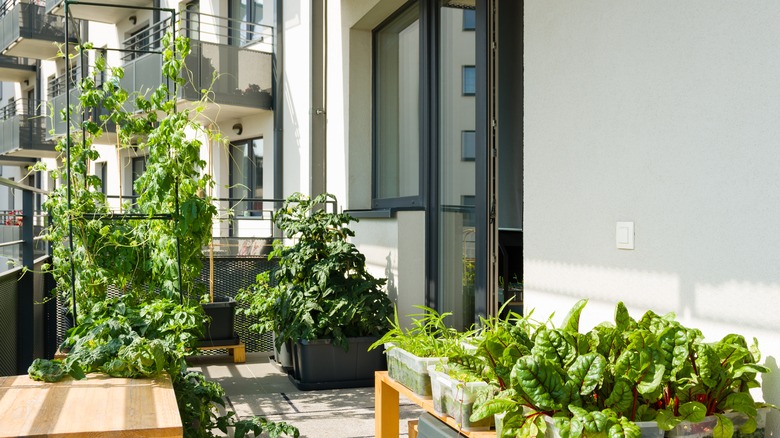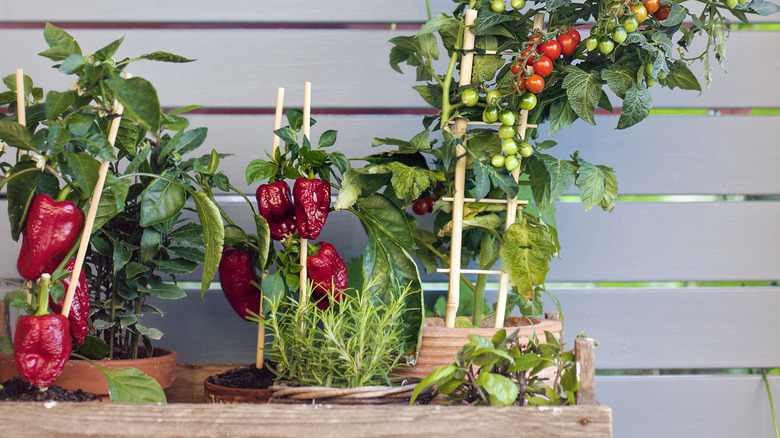The Simple Gardening Practice That Makes Growing Vegetables A Breeze
We may receive a commission on purchases made from links.
If you are a vegetable gardener, you likely know how beneficial container gardening can be. Not only are containers great for growing veggies if you are short on space, but container gardening also reduces soil-borne diseases, provides better protection from pests, limits weed issues, and is handy for single-use harvesting. Plus, there's a way to make container gardening even easier.
A grow table will elevate your container garden game, literally and figuratively. They make maintaining and harvesting your veggies a total breeze — no more bending over and crawling around on your hands and knees. You get all the aforementioned benefits of container gardening and enhanced accessibility to your plants. Elevating your container plants with grow tables also provides even greater pest protection, so your veggies can grow undisturbed and at just the right height for easy peas-y harvesting (pun intended).
Building your own grow table is a simple DIY project and you can utilize wood scraps or offcuts to get the job done. You can also customize your grow tables according to your container sizes so they'll be just the right height for whatever you're growing.
Tips to build a grow table for container gardening
There are lots of elevated planter boxes on the market that get your garden off the ground, such as the highly-rated Best Choice Products Raised Garden Bed on Amazon. These tables are designed to be filled with soil and used just like you would an in-ground garden patch so plants grow together instead of in separate containers. Elevated planter boxes are also easy to DIY as long as you follow a few essential tips so your plants can thrive in homemade wooden planters.
But if you want to keep your veggies separate, you can DIY a simplified grow table just for your container plants. A grow table is just a basic, reinforced table frame with a slatted tabletop. Two-by-two boards spaced 1½ inches apart on the top ensure adequate drainage for your containers. For most average-sized containers (less than 5 gallons), a grow table around 30 inches tall will be perfect. If you are using 5-gallon containers or larger, you may want your table to be lower for easier access.
Homesteaders and YouTubers, Hollis and Nancys Homestead, offer a highly detailed tutorial to build your own grow table for your container plants. You can modify the basic idea to fit your space and needs and even upcycle wood scraps to build your table. The keys to a good grow table are simply to make your garden easily accessible while also providing proper drainage so your plants will thrive and your table will last.
The best veggies to grow on your grow table
While not every plant is well-suited for containers, there are lots of easy-to-grow vegetables that will thrive in a container garden. Broccoli, green onions, cucumbers, cauliflower, tomatoes, cabbages, peppers, and even potatoes (in big planters) are great candidates for containers, just to name a few. Containers are also easy to experiment with. If you have been struggling to grow a certain vegetable in your garden patch, try using a container instead to see if it does better being protected from soil-borne diseases and pests.
It's helpful to size your planters correctly to help your vegetables thrive. One basic rule of thumb is to double the size of the root ball to make sure you are giving it enough space in your container. On average, a vegetable root system goes anywhere from 9 to 12 inches deep.
Container gardening using grow tables makes growing vegetables just about as easy as it gets. They keep your plants accessible and protected, they make cleaning vegetables a breeze (especially leafy greens as less soil backsplash from rain and watering means less gritty leaves), and you can easily harvest small quantities of your vegetables as needed. No matter what you grow in your container garden, your plants — and your back! — will thank you for using a grow table.

